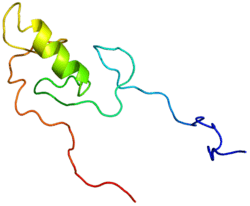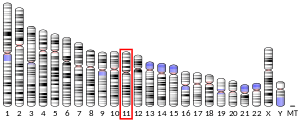TRIM5alpha
Tripartite motif-containing protein 5 also known as RING finger protein 88 is a protein that in humans is encoded by the TRIM5 gene.[4] The alpha isoform of this protein, TRIM5α, is a retrovirus restriction factor, which mediates species-specific, early block to retrovirus infection.
TRIM5α is composed of 493 amino acids that is found in the cells of most primates. TRIM5α is an intrinsic immune factor important in the innate immune defense against retroviruses, along with the APOBEC family of proteins,[5][6] tetherin and TRIM22.
Structure
TRIM5α belongs to the TRIM protein family (TRIM stands for TRIpartite Motif); this family was first identified by Reddy in 1992 as proteins that contain a RING finger zinc binding domain, a B-box zinc binding domain, followed by a coiled-coil region.[7] TRIM5α bears the C-terminal PRY-SPRY or B30.2 domain in addition to the other domains.
Function
When a retrovirus enters a host cell's cytoplasm, it undergoes capsid uncoating and reverse transcription. TRIM5 is present in the cytoplasm and recognizes motifs within the capsid proteins that interferes with the uncoating process, therefore preventing successful reverse transcription and transport to the nucleus of the viral genome.[8][9] The exact mechanism of action has not been shown conclusively, but capsid protein from restricted viruses is removed by proteasome-dependent degradation.[10]
The involvement of other cellular proteins in the inhibition mediated by TRIM5α is suspected but as yet not demonstrated. However, Cyclophilin A is important for the inhibition of HIV-1 by TRIM5α in Old World monkey species.[11]
The "specificity" of restriction, that is, whether a given retrovirus can be targeted by TRIM5α, is entirely determined by the amino acid sequence of the C-terminal domain of the protein, called the B30.2/PRY-SPRY domain.[12] Amino acid 332, which occurs within this domain, seems to play a critical role in determining the specificity of retrovirus restriction.[13][14]
TRIM5α may have played a critical role in the human immune defense system about 4 million years ago, when the retrovirus PtERV1 was infecting the ancestors of modern chimpanzees.[14] While no trace of PtERV1 has yet been found in the human genome, about 130 traces of PtERV1 DNA have been found in the genome of modern chimpanzees. After recreating part of the PtERV1 retrovirus, it was reported that TRIM5α prevents the virus from entering human cells in vitro. While this cellular defense mechanism may have been very useful 4 million years ago when facing a PtERV1 epidemic, it has the side effect of leaving cells more susceptible to attack by the HIV-1 retrovirus. Recently, doubt has been cast over these conclusions. By using a PtERV1 capsid, which produces higher titer virus-like particles, Perez-Caballero et al. reported that PtERV1 is not restricted by either human or chimpanzee TRIM5α.[15]
Clinical significance
Old World monkeys cannot be infected with HIV-1, the virus that causes AIDS in humans; they can be infected, however, with SIV, a related virus. TRIM5α was isolated as a rhesus macaque protein responsible for blocking infection by HIV-1.[16]
The human version of TRIM5α does not block HIV-1, but can inhibit strains of the murine leukemia virus (MLV)[17][18] as well as equine infectious anemia virus (EIAV).[19][20]
Prior to the discovery of TRIM5α as an antiviral protein, the inhibition phenotype had been described and coined Ref1 (in human cells) and Lv1 (in monkey cells). This terminology is now largely abandoned.
A related protein, named TRIMCyp (or TRIM5-CypA), was isolated in the owl monkey, a species of New World monkey, and shown to potently inhibit infection by HIV-1.[21] A similar protein has arisen independently in Old World monkeys and has been identified in several species of macaque.[22][23]
It was recently described that interferon-α-mediated stimulation of the immunoproteasome enables human TRIM5α for effective capsid-dependent inhibition of HIV-1 DNA synthesis and infection.[24]
Notes and references
- GRCh38: Ensembl release 89: ENSG00000132256 - Ensembl, May 2017
- "Human PubMed Reference:". National Center for Biotechnology Information, U.S. National Library of Medicine.
- "Mouse PubMed Reference:". National Center for Biotechnology Information, U.S. National Library of Medicine.
- Reymond A, Meroni G, Fantozzi A, Merla G, Cairo S, Luzi L, Riganelli D, Zanaria E, Messali S, Cainarca S, Guffanti A, Minucci S, Pelicci PG, Ballabio A (May 2001). "The tripartite motif family identifies cell compartments". EMBO J. 20 (9): 2140–51. doi:10.1093/emboj/20.9.2140. PMC 125245. PMID 11331580.
- Cullen BR (2006). "Role and mechanism of action of the APOBEC3 family of antiretroviral resistance factors". J. Virol. 80 (3): 1067–76. doi:10.1128/JVI.80.3.1067-1076.2006. PMC 1346961. PMID 16414984.
- Zhang KL, Mangeat B, Ortiz M, Zoete V, Trono D, Telenti A, Michielin O (2007). Aballay A (ed.). "Model structure of human APOBEC3G". PLOS ONE. 2 (4): e378. Bibcode:2007PLoSO...2..378Z. doi:10.1371/journal.pone.0000378. PMC 1849894. PMID 17440614.

- Reddy BA, Etkin LD, Freemont PS (1992). "A novel zinc finger coiled-coil domain in a family of nuclear proteins". Trends Biochem. Sci. 17 (9): 344–5. doi:10.1016/0968-0004(92)90308-V. PMID 1412709.
- Sebastian S, Luban J (2005). "TRIM5alpha selectively binds a restriction-sensitive retroviral capsid". Retrovirology. 2: 40. doi:10.1186/1742-4690-2-40. PMC 1166576. PMID 15967037.
- Stremlau M, Perron M, Lee M, Li Y, Song B, Javanbakht H, Diaz-Griffero F, Anderson DJ, Sundquist WI, Sodroski J (2006). "Specific recognition and accelerated uncoating of retroviral capsids by the TRIM5alpha restriction factor". Proc. Natl. Acad. Sci. U.S.A. 103 (14): 5514–9. doi:10.1073/pnas.0509996103. PMC 1459386. PMID 16540544.
- Wu X, Anderson JL, Campbell EM, Joseph AM, Hope TJ (2006). "Proteasome inhibitors uncouple rhesus TRIM5alpha restriction of HIV-1 reverse transcription and infection". Proc. Natl. Acad. Sci. U.S.A. 103 (19): 7465–70. Bibcode:2006PNAS..103.7465W. doi:10.1073/pnas.0510483103. PMC 1464362. PMID 16648264.
- Berthoux L, Sebastian S, Sokolskaja E, Luban J (2005). "Cyclophilin A is required for TRIM5α-mediated resistance to HIV-1 in Old World monkey cells". Proc. Natl. Acad. Sci. U.S.A. 102 (41): 14849–53. Bibcode:2005PNAS..10214849B. doi:10.1073/pnas.0505659102. PMC 1239943. PMID 16203999.
- Ohkura S, Yap MW, Sheldon T, Stoye JP (2006). "All three variable regions of the TRIM5alpha B30.2 domain can contribute to the specificity of retrovirus restriction". J. Virol. 80 (17): 8554–65. doi:10.1128/JVI.00688-06. PMC 1563890. PMID 16912305.
- Yap MW, Nisole S, Stoye JP (2005). "A single amino acid change in the SPRY domain of human Trim5alpha leads to HIV-1 restriction". Curr. Biol. 15 (1): 73–8. doi:10.1016/j.cub.2004.12.042. PMID 15649369.
- Kaiser SM, Malik HS, Emerman M (2007). "Restriction of an extinct retrovirus by the human TRIM5alpha antiviral protein". Science. 316 (5832): 1756–8. Bibcode:2007Sci...316.1756K. doi:10.1126/science.1140579. PMID 17588933.
- Perez-Caballero D, Soll SJ, Bieniasz PD (2008). Hope TJ (ed.). "Evidence for restriction of ancient primate gammaretroviruses by APOBEC3 but not TRIM5alpha proteins". PLOS Pathog. 4 (10): e1000181. doi:10.1371/journal.ppat.1000181. PMC 2564838. PMID 18927623.

- Stremlau M, Owens CM, Perron MJ, Kiessling M, Autissier P, Sodroski J (2004). "The cytoplasmic body component TRIM5alpha restricts HIV-1 infection in Old World monkeys". Nature. 427 (6977): 848–53. Bibcode:2004Natur.427..848S. doi:10.1038/nature02343. PMID 14985764.
- Lee K, KewalRamani VN (2004). "In defense of the cell: TRIM5α interception of mammalian retroviruses". Proc. Natl. Acad. Sci. U.S.A. 101 (29): 10496–7. doi:10.1073/pnas.0404066101. PMC 489964. PMID 15252204.
- Yap MW, Nisole S, Lynch C, Stoye JP (2004). "Trim5α protein restricts both HIV-1 and murine leukemia virus". Proc. Natl. Acad. Sci. U.S.A. 101 (29): 10786–91. Bibcode:2004PNAS..10110786Y. doi:10.1073/pnas.0402876101. PMC 490012. PMID 15249690.
- Hatziioannou T, Perez-Caballero D, Yang A, Cowan S, Bieniasz PD (2004). "Retrovirus resistance factors Ref1 and Lv1 are species-specific variants of TRIM5α". Proc. Natl. Acad. Sci. U.S.A. 101 (29): 10774–9. Bibcode:2004PNAS..10110774H. doi:10.1073/pnas.0402361101. PMC 490010. PMID 15249685.
- Keckesova Z; Ylinen LM; Towers GJ (2004). "The human and African green monkey TRIM5αgenes encode Ref1 and Lv1 retroviral restriction factor activities". Proc. Natl. Acad. Sci. U.S.A. 101 (29): 10780–5. Bibcode:2004PNAS..10110780K. doi:10.1073/pnas.0402474101. PMC 490011. PMID 15249687.
- Sayah DM, Sokolskaja E, Berthoux L, Luban J (2004). "Cyclophilin A retrotransposition into TRIM5 explains owl monkey resistance to HIV-1". Nature. 430 (6999): 569–73. Bibcode:2004Natur.430..569S. doi:10.1038/nature02777. PMID 15243629.
- Wilson SJ, Webb BL, Ylinen LM, Verschoor E, Heeney JL, Towers GJ (2008). "Independent evolution of an antiviral TRIMCyp in rhesus macaques". PNAS. 105 (9): 3557–62. doi:10.1073/pnas.0709003105. PMC 2265179. PMID 18287035.
- Brennan G, Kozyrev Y, Hu SL (2008). "TRIMCyp expression in Old World primates Macaca nemestrina and Macaca fascicularis". PNAS. 105 (9): 3569–74. doi:10.1073/pnas.0709511105. PMC 2265124. PMID 18287033.
- Malim, Michael H.; Gilberto Betancor; Apolonia, Luis; Jimenez-Guardeño, Jose M. (2019-03-18). "Immunoproteasome activation enables human TRIM5α restriction of HIV-1". Nature Microbiology. 4 (6): 933–940. doi:10.1038/s41564-019-0402-0. ISSN 2058-5276. PMC 6544544. PMID 30886358.
External links
- "UniProtKB/Swiss-Prot entry Q587N7 (TRIM5_CERAE) Tripartite motif-containing protein 5". Swiss Institute of Bioinformatics. Retrieved 2008-02-19.
- "NCBI Sequence Viewer v2.0". National Center for Biotechnology Information. Retrieved 2008-02-19.
- Minkel JR (2007-06-21). "Defense against Ancient Virus Opened Door to HIV". Scientific American. Retrieved 2008-02-19.
- Hopkin M (2007-06-26). "Access : Ancient disease resistance made us vulnerable to HIV". Nature News. doi:10.1038/news070618-15. Retrieved 2008-02-19.
- Overview of all the structural information available in the PDB for UniProt: Q9C035 (Tripartite motif-containing protein 5) at the PDBe-KB.



